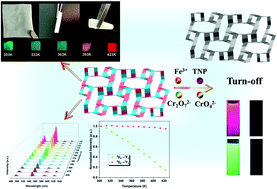Lanthanide-MOFs as multifunctional luminescent sensors†
Abstract
Five isostructural lanthanide metal–organic frameworks [Ln(BDPO)(H2O)4] (Ln = Eu for CUST-623, Tb for CUST-624, Gd for CUST-625, Dy for CUST-626, and Sm for CUST-627, BDPO = N,N′ bis(3,5-dicarboxyphenyl)-oxalamide) were synthesized by the solvothermal method. Single-crystal X-ray diffraction shows that Ln-MOFs manifest framework structures with two kinds of 1D open channels in the b-axis direction. Dual emission luminescent thermometer films were successfully prepared by immobilizing EuxTb0.02−x-BDPO into polyvinyl alcohol (PVA) aqueous solution, which features the integrity of MOF powders, proving their excellent processability. Moreover, Eu0.002Tb0.018-BDPO@PVA shows excellent temperature sensing performance with a high sensitivity of 3.7% K−1 in the temperature range of 303 K–423 K. CUST-623 and CUST-624 can be used as multiresponse fluorescent sensors for detecting Fe3+, Cr2O72−, CrO42− and TNP. In addition, the mechanism of fluorescence sensing is investigated by infrared (IR) spectroscopy, powder X-ray diffraction (PXRD) and ultraviolet–visible (UV-vis) spectroscopy. This work provides a general method for constructing Ln-MOF sensor materials with multifunctional luminescence characteristics.



 Please wait while we load your content...
Please wait while we load your content...